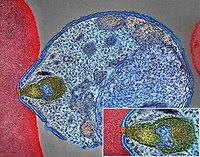
Photo from wikipedia
Abstract The genome of Plasmodium falciparum, the causative agent of malaria in Africa, has been extensively studied since it was first fully sequenced in 2002. However, many open questions remain,… Click to show full abstract
Abstract The genome of Plasmodium falciparum, the causative agent of malaria in Africa, has been extensively studied since it was first fully sequenced in 2002. However, many open questions remain, including understanding the chromosomal context of molecular evolutionary changes (e.g., relationship between chromosome map and phylogenetic conservation, patterns of gene duplication, and patterns of selection). Here, we present PhyloChromoMap, a method that generates a phylogenomic map of chromosomes from a custom-built bioinformatics pipeline. Using P. falciparum 3D7 as a model, we analyze 2,116 genes with homologs in up to 941 diverse eukaryotic, bacterial and archaeal lineages. We estimate the level of conservation along chromosomes based on conservation across clades, and identify “young” regions (i.e., those with recent or fast evolving genes) that are enriched in subtelomeric regions as compared with internal regions. We also demonstrate that patterns of molecular evolution for paralogous genes differ significantly depending on their location as younger paralogs tend to be found in subtelomeric regions whereas older paralogs are enriched in internal regions. Combining these observations with analyses of synteny, we demonstrate that subtelomeric regions are actively shuffled among chromosome ends, which is consistent with the hypothesis that these regions are prone to ectopic recombination. We also assess patterns of selection by comparing dN/dS ratios of gene family members in subtelomeric versus internal regions, and we include the important antigenic gene family var. These analyses illustrate the highly dynamic nature of the karyotype of P. falciparum, and provide a method for exploring genome dynamics in other lineages.
Journal Title: Genome Biology and Evolution
Year Published: 2018
Link to full text (if available)
Share on Social Media: Sign Up to like & get
recommendations!